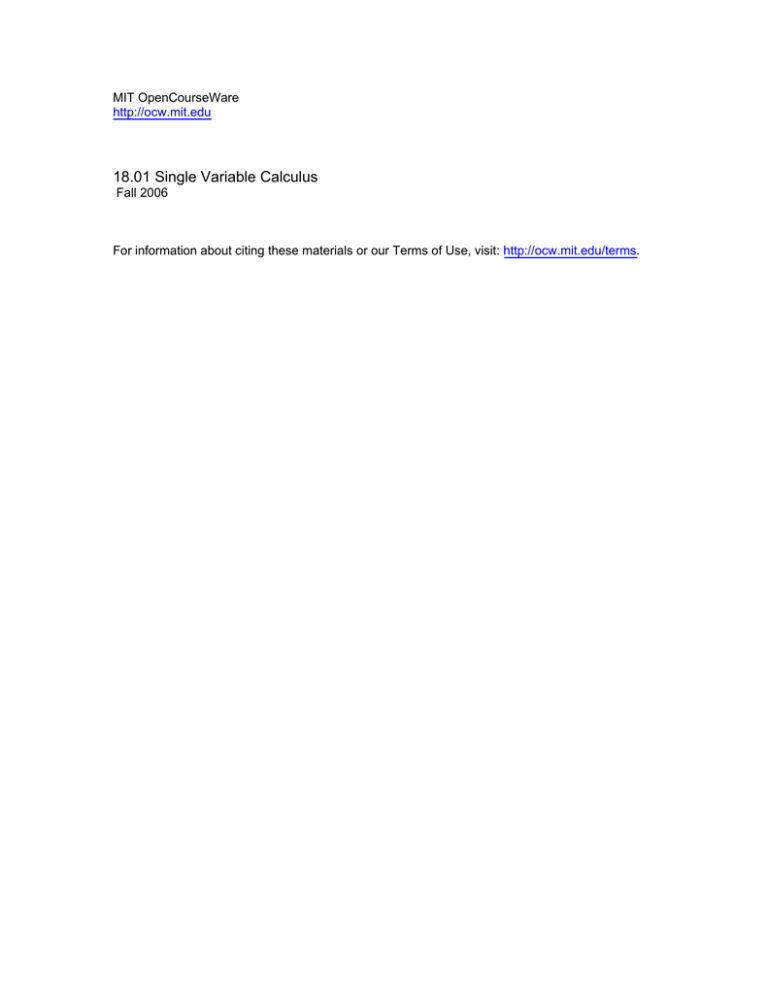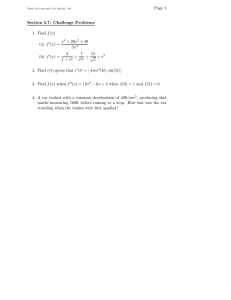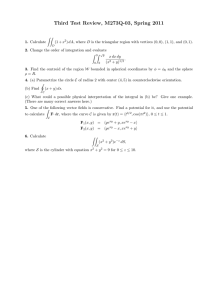18.01 Single Variable Calculus MIT OpenCourseWare Fall 2006
advertisement

MIT OpenCourseWare http://ocw.mit.edu 18.01 Single Variable Calculus Fall 2006 For information about citing these materials or our Terms of Use, visit: http://ocw.mit.edu/terms. Lecture 31 18.01 Fall 2006 Lecture 31: Parametric Equations, Arclength, Surface Area Arclength, continued Example 1. Consider this parametric equation: x = t2 x3 = (t2 )3 = t6 ; y = t3 y 2 = (t3 )2 = t6 for 0 ≤ t ≤ 1 =⇒ x3 = y 2 =⇒ y = x2/3 ds ds dy dx 0≤x≤1 dy dx Figure 1: Infinitesimal Arclength. (ds)2 = (dx)2 + (dy)2 (2t dt)2 + (3t2 dt)2 = (4t2 + 9t4 )(dt)2 � �� � � �� � (dx)2 (dy)2 � t=1 � 1� � 1 � 2 4 Length = ds = 4t + 9t dt = t 4 + 9t2 dt (ds)2 = t=0 0 0 2 3/2 �1 (4 + 9t ) � 1 (133/2 − 43/2 ) � = 27 27 0 Even if you can’t evaluate the integral analytically, you can always use numerical methods. = 1 Lecture 31 18.01 Fall 2006 Surface Area (surfaces of revolution) y ds y a b x Figure 2: Calculating surface area ds (the infinitesimal curve length in Figure 2) is revolved a distance 2πy. The surface area of the thin strip of width ds is 2πy ds. Example 2. Revolve Example 1 (x = t2 , y = t3 , 0 ≤ t ≤ 1) around the x-axis. Refer to Figure 3. y x Figure 3: Curved surface of a trumpet. 2 Lecture 31 18.01 Fall 2006 Area = 1 � � 2πy ds = 2π 0 t3 ���� y � � 1 � t 4 + 9t2 dt t4 4 + 9t2 dt � �� � = 2π 0 ds Now, we discuss the method used to evaluate � t4 (4 + 9t2 )1/2 dt We’re going to ignore the factor of 2π. You can reinsert it once you’re done evaluating the integral. We use the trigonometric substitution t= 2 tan u; 3 dt = 2 sec2 u du; 3 tan2 u + 1 = sec2 u Putting all of this together gives us: � t4 (4 + 9t2 )1/2 dt �4 � � ��1/2 � � 2 4 2 tan u 4+9 tan2 u sec2 u du 3 9 3 � �5 � 2 tan4 u(2 sec u)(sec2 u du) 3 � � = = This is a tan − sec integral. It’s doable, but it will take a long time for you to work the whole thing out. We’re going to stop evaluating it here. Example 3 Let’s use what we’ve learned to find the surface area of the unit sphere (see Figure 4). y rotate the curve by 2π radians a . . b x Figure 4: Slice of spherical surface (orange peel, only, not the insides). 3 Lecture 31 18.01 Fall 2006 For the top half of the sphere, � 1 − x2 y= We want to find the area of the spherical slice between x = a and x = b. A spherical slice has area � x=b A= 2πy ds x=a From last time, dx ds = √ 1 − x2 Plugging that in yields a remarkably simple formula for A: � A= b 2π � 1 − x2 √ a dx = 1 − x2 = 2π(b − a) Special Cases For a whole sphere, a = −1, and b = 1. 2π(1 − (−1)) = 4π is the surface area of a unit sphere. For a half sphere, a = 0 and b = 1. 2π(1 − 0) = 2π 4 � b 2π dx a





